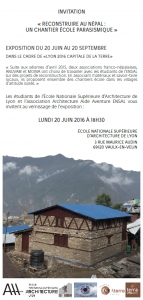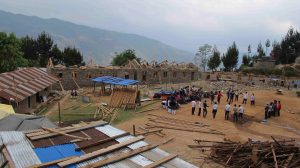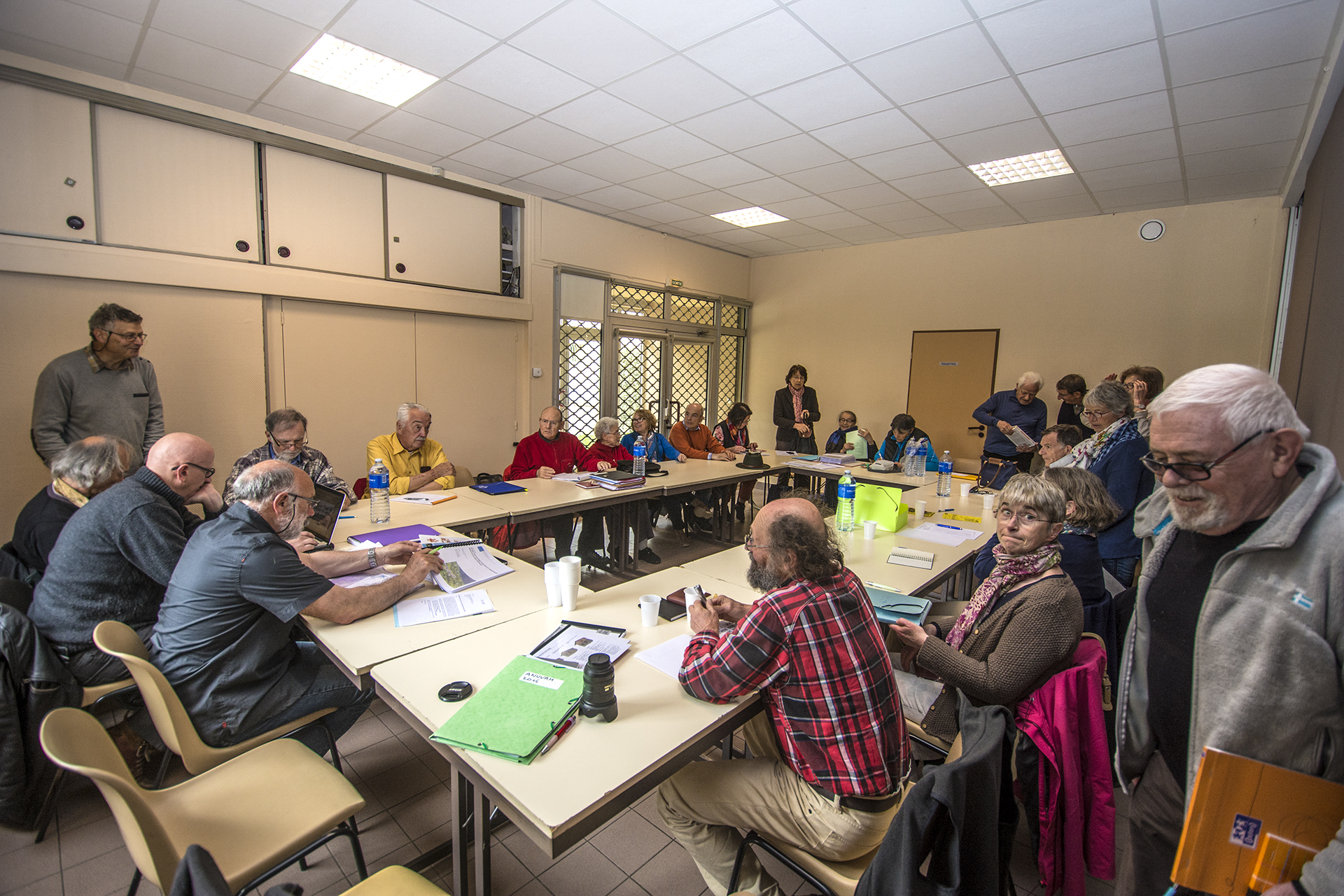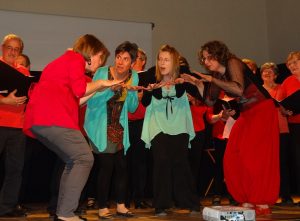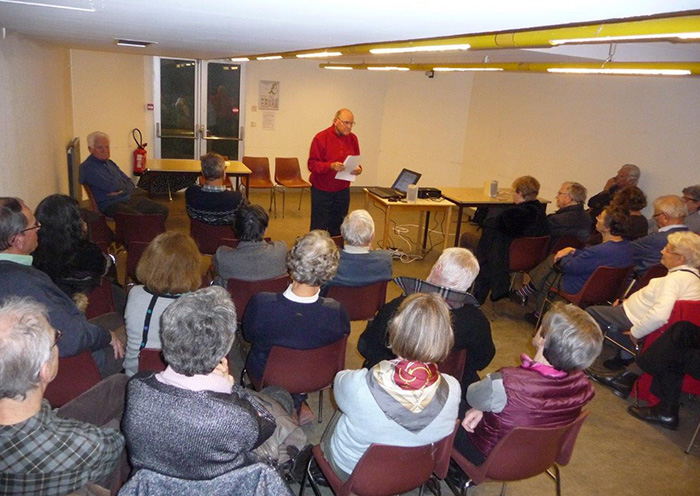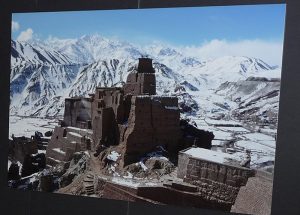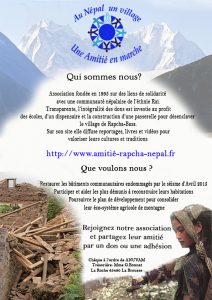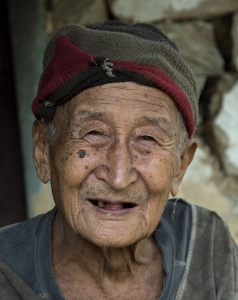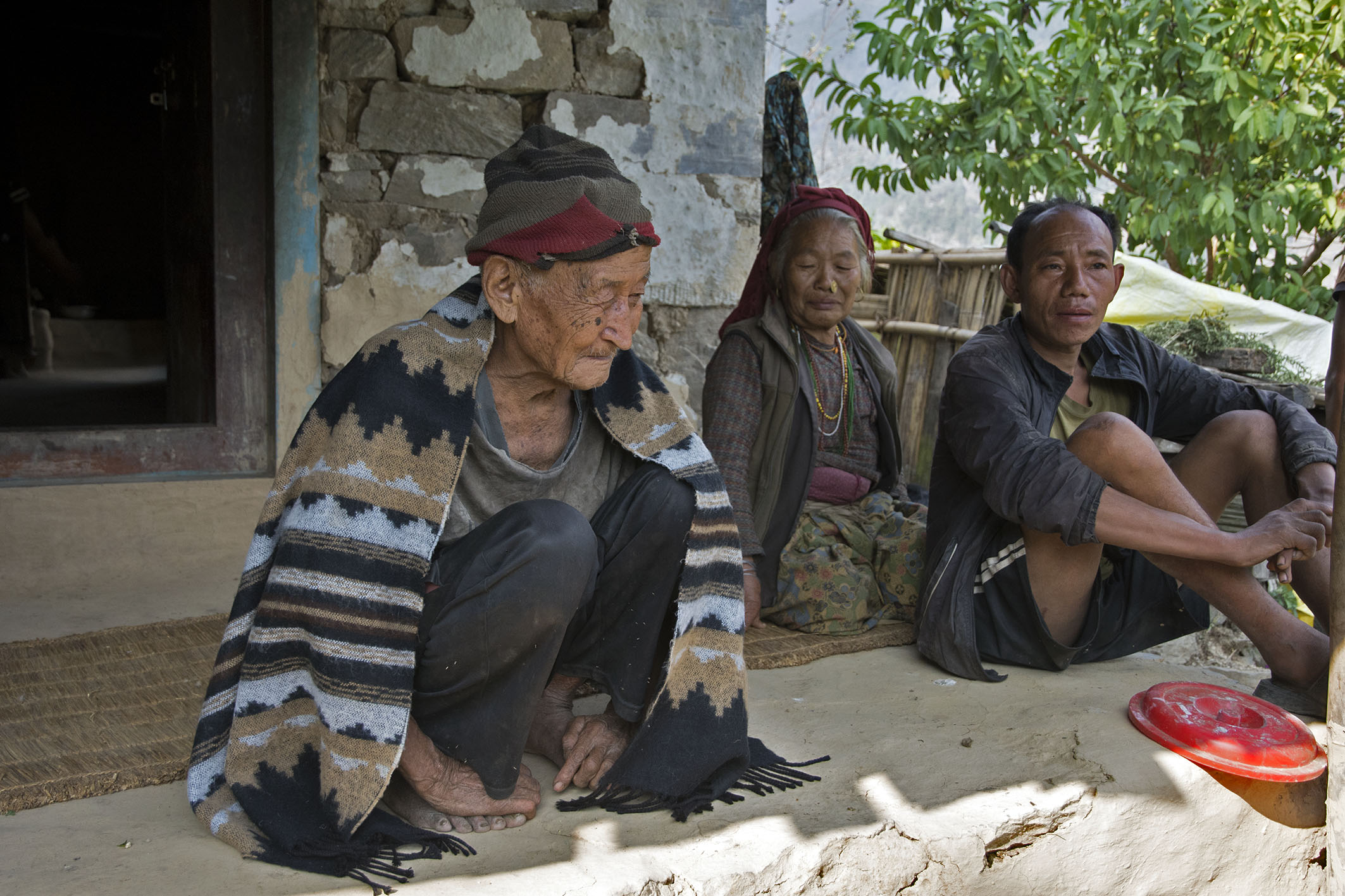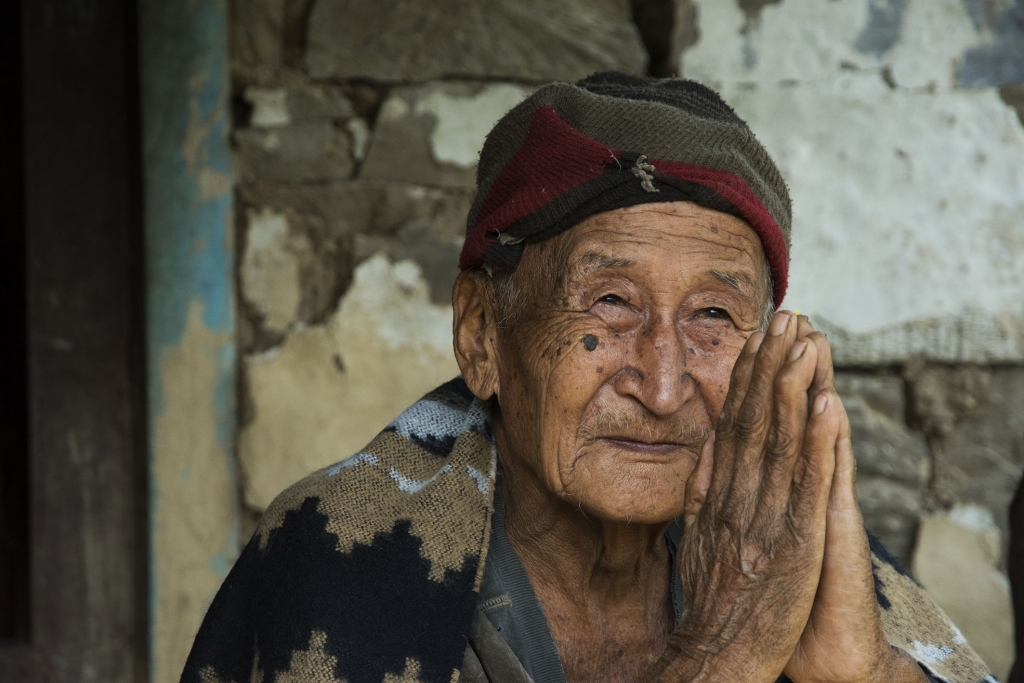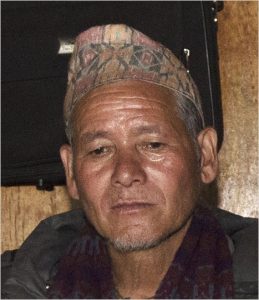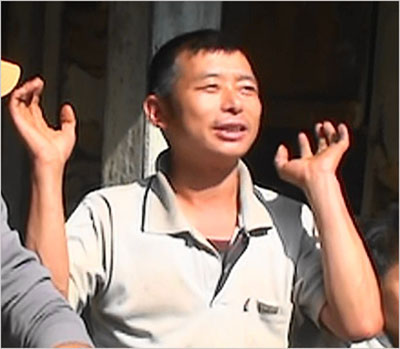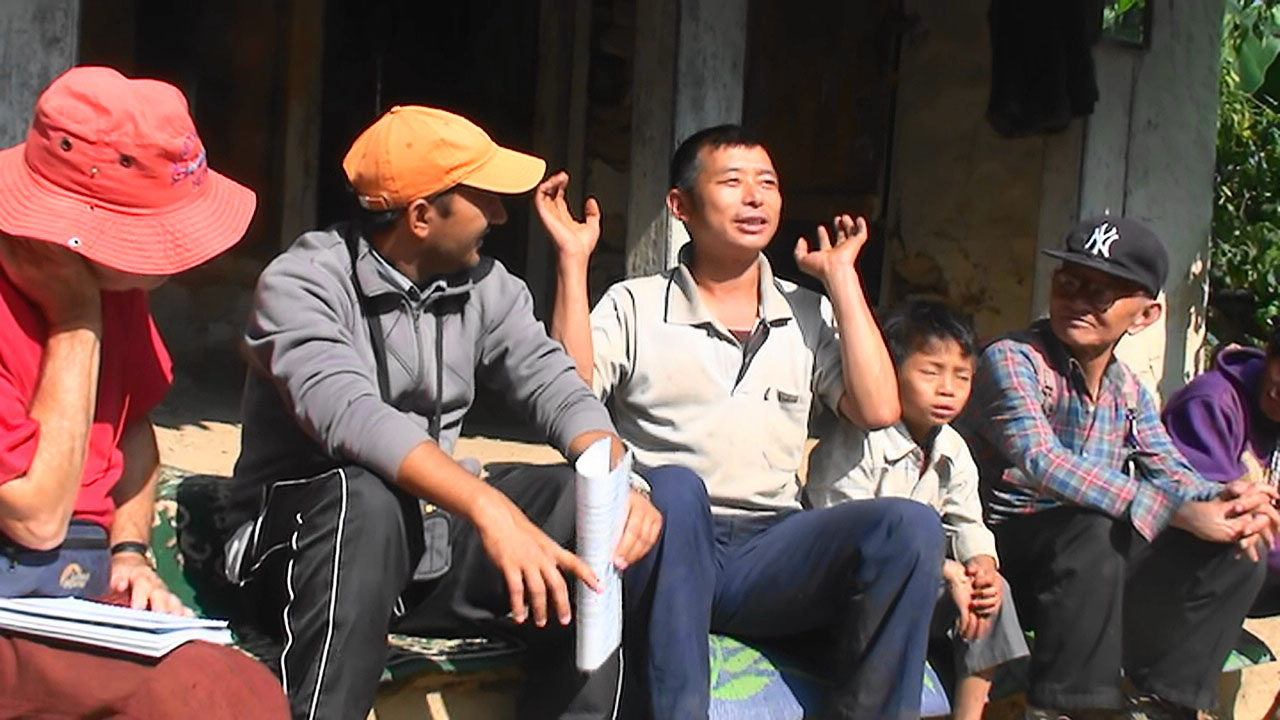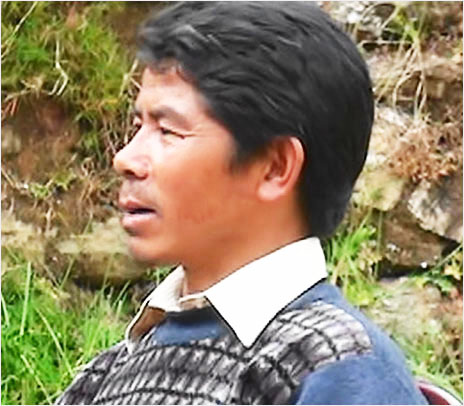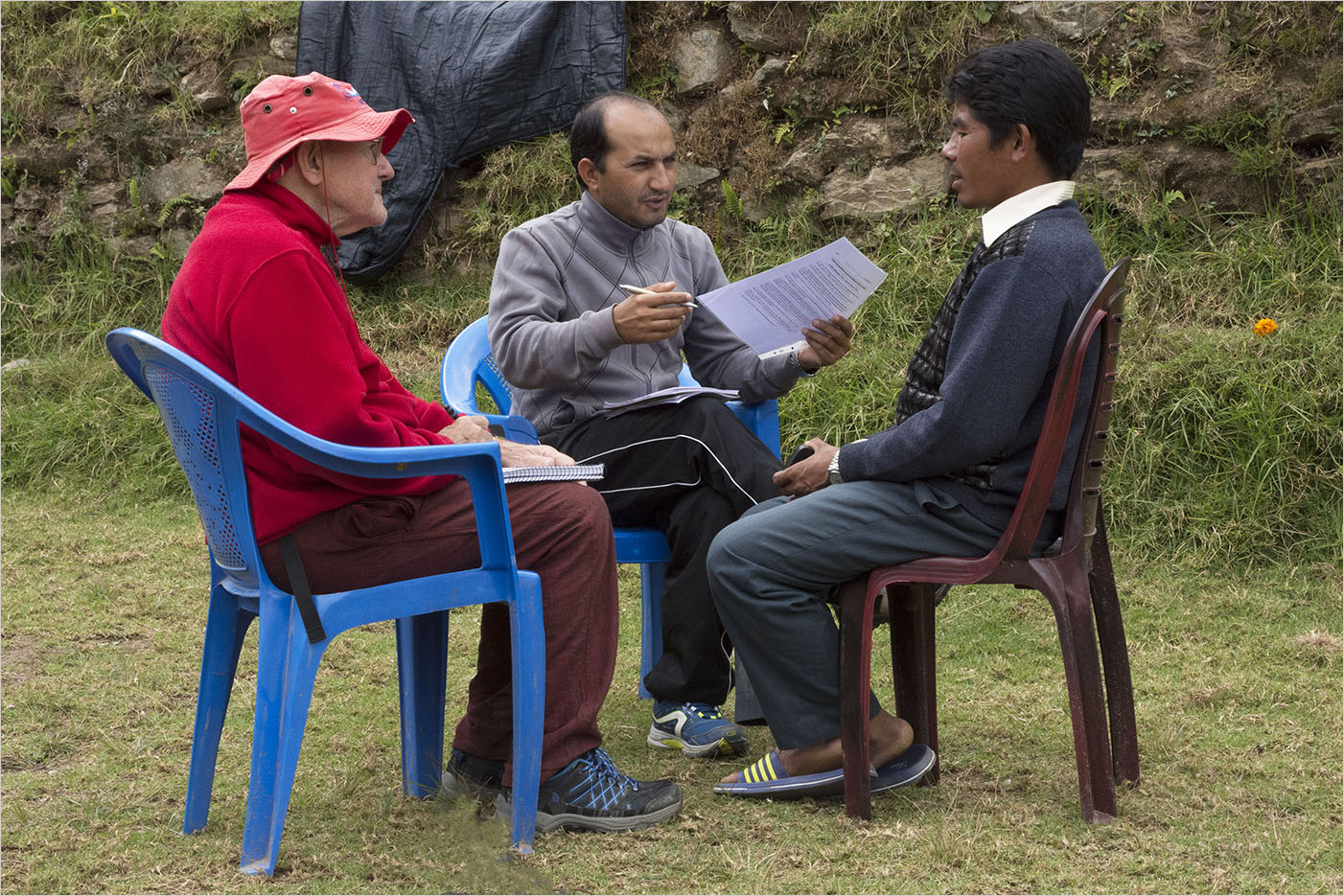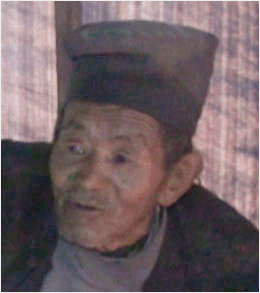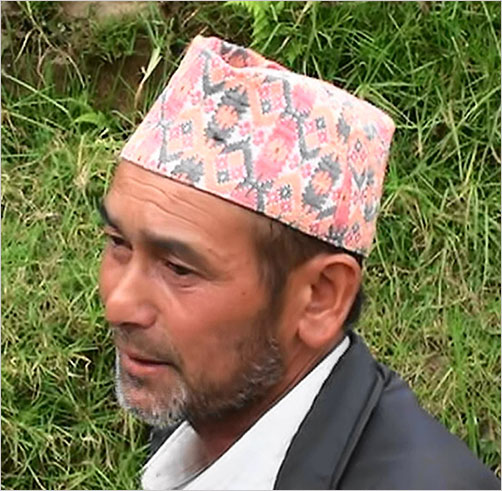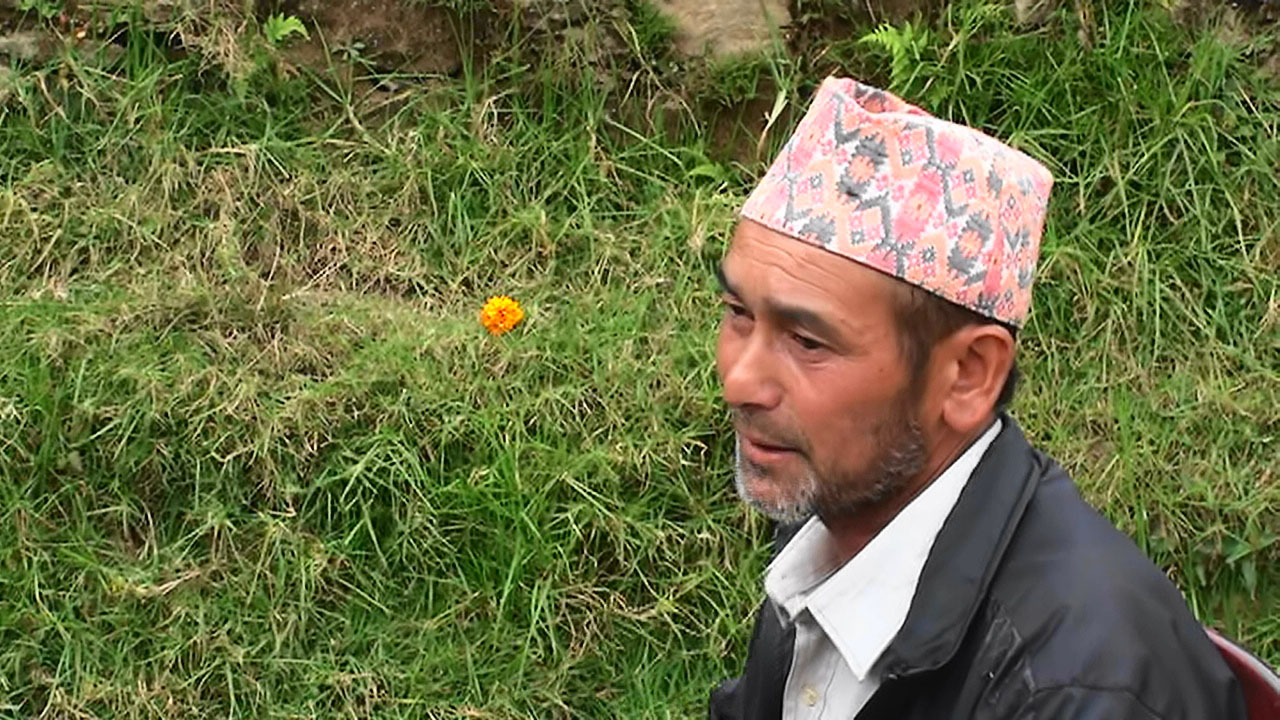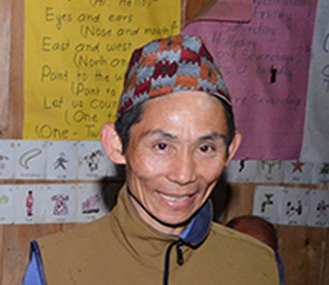The situation in Rapcha, June 2016
The anti-seismic standards recommended by the architects and engineers with whom we have been working for the past year have been complied with to the letter.
Info … France-Diplomatie
Testimonies on the website: follow the link >
ANUVAM General Meeting 2016
The plans for rebuilding the village of Basa-Rapcha were discussed at length.
Bernard Simonet, President of ANUVAM, left immediately afterwards for Nepal to define the implementation of the first training site, set up in collaboration with teachers and students from the Ecole Nationale Supérieure d’Architecture de Lyon (ENSAL). The project will start in October, after the monsoon season.
St Genès Champanelle, 23 April 2016
- “In Nepal, a village, a friendship on the move”, Anuvam
- “Solida Sherpa (Nepal),
- “Ocre rouge” (Madagascar)
The donations collected will help these 3 associations in their mission.
Himalaya, reflections of a journey
Exhibition by Philippe Mussot (February 2016)
Philippe Mussot’s photo exhibition on the Himalayas from 4 February to 5 April.
Location:
CFDT building
Avenue Simon Bolivar, Paris 19ème
Opening on 4 February at 1.30 pm
With the participation of ANUVAM
Meeting with Aai Bahadur Rai
Elisabeth and Jean Claude Raimbault met a centenarian who lived through the 1934 earthquake in Bodu, one of the hamlets of Rapcha.
The 2015 earthquake destroyed his house.
For him, the 2015 earthquake was stronger than the one in 1934.
But there were landslides and a lot of trees fell. This man remembers that one person’s leg was broken in a landslide when a rock hit his leg.
In 1934, the movement was very strong, but it lasted 40 to 45 seconds and there were no aftershocks. In 2015, the earthquake lasted longer and there were several types of tremor: it rotated, shook and there were many aftershocks.
His house and his son’s house are damaged. His house is not badly damaged, but his son’s is very badly damaged.
Interview with Aai Bahadur Rai
JC Raimbault – November 2015
The story of Yam Bahadur Magar
He is recognised by the whole community as an outstanding master carpenter and master builder, as he manages building sites all over Nepal. He taught himself his trade and is often absent from the village, even though he is a farmer like everyone else.
His house has been declared uninhabitable (a number of cracks), but Tara has shown him how to repair it.
On 25 April, around midday, I was in the fields and it was a bit cold. On 12 May I was up in the mountains, harvesting wild honey. I was walking up the Koledo slope with a friend when the earthquake hit. I grabbed him with one hand and held on to a tree with the other. I was so scared. It was unimaginable. The mountains were moving. I thought it was the end of my life. I saw several landslides in Koledo.
Afterwards, people gathered and looked for protected places. They looked for food and objects to protect them from further earthquakes. They went into destroyed houses to rescue people and belongings. The children were shaking, crying and scared. Everyone thought they were going to die. It was a terrible situation. If the earthquake had happened at night, there would have been deaths, like in my house where material collapsed on our bed. For 2 or 3 days I tried to save the people and the most important things, because I have political responsibilities in the village.
The problem quickly became how to sleep. We prepared a temporary shelter with woven bamboo fences, mats and plastic sheeting for the night. At first we all got together: Rai, Magar, BK (Dalit). We wanted to be together to die together or to help each other. For 25 days, 80 of us lived in the temporary shelter because the aftershocks wouldn’t stop.
When the earthquake struck on 25 April, the first thing we said to each other was to get out of the houses. On 12 May, with my friend in Koledo, we immediately said that we had to go into the houses to get the news.
We can’t know the cause of these earthquakes. It’s God who decides. Because there are things that don’t work properly: dishonest people, no discipline. It’s a punishment sent by God.
The second earthquake caused numerous landslides (Koledo). Information from Namche led us to believe that the Dudhkosi river was blocked (by landslides) and that this was going to flood the lower parts of Rapcha. So we had to get the people living in the lower parts of Rapcha, in the hamlets of Bodu and Lop, to move up. A little later the police came to find out if there were any victims. They visited each house to take stock of the destruction.
When I think back to those moments, I say to myself that if these tremors had happened at night with the inhabitants in their houses, there would have been no chance of survival. With the fragile soil and the houses weakened by the first tremor, life in Rapcha was over. And so I asked God to protect the Nepalese, to stop the earthquakes.
After the earthquakes, people’s opinions changed. They now know that you have to build earthquake-proof houses that aren’t too big, that you have to protect children with earthquake-proof schools.
I was disappointed by the state aid. The police and administration have done a poor job. There was favouritism for people close to them, including NGOs. There was no transparency. I spent two months living in Namche. I saw that there was no strategy to help the victims and that aid went to those who didn’t need it most.
For the future, when it comes to aid, we need to think about a classification that distinguishes between people who need help the most and those who can rebuild on their own.
The story of Naïna Bahadur Raï
Naïna Bahadur Rai is 31 years old.
He is a farmer and is well educated, having completed his SLC. He is also a porter on treks, which brings in a bit of money for the house.
Naïna’s situation after the earthquake is the same as that described for Dan Kumari Rai, as he is her husband.
On 25 April I was on the roof of the house we were building with 18 people when the earthquake hit. I immediately jumped off the roof. I could see the trees moving, everything was moving. The 18 companions ran away; they went back to their homes and their families. Around my house there was no great destruction. People were shouting. There were landslides across the river, on the other bank of the Dudhkosi. Following this disaster, Padam, my father, fell ill and died two months later. I remember that at the time of the earthquake, it was a bit cold.
During the second earthquake, I was planting maize and turning over the soil with the two buffalos. Everything started to move, everything was moving, on the opposite bank too. There were loud noises. My house broke. It was unimaginable, incredible. I was so scared. I knew not to go back into the house. After that, 45 people gathered near my house, in the greenhouse.
These people stayed in the greenhouse for 15 days. They wanted to die together if there was another earthquake. But it was difficult for 45 people to live together for much longer. So we built temporary shelters for the families. To survive, we had to go into the houses to get food and belongings, but we were scared. Then we shared what we found.
On the day of the first earthquake, I looked for somewhere to protect myself. I also looked for food. After the second earthquake, we visited the houses to see if there were any victims.
After the first tremor, the 18 people said that if there was another tremor, it would no longer be possible to live here. After the second earthquake, a neighbour and I said to each other: “We’re going to die”.
Older people thought that the gods were unhappy because of the dishonesty of the Nepalese, because there were too many people on earth, because of the actions of politicians. But for educated people, there is water and earth. For them, the Tibetan tectonic plates are moving towards Nepal and this produces earthquakes. It can take two or three years for the Tibetan tectonic plate to stabilise and for the earthquakes to stop.
In the discussions that followed, we realised that the most important thing was to protect the family, the food and the animals. Then the radio gave the news: all the deaths in Kathmandu, all the destruction of buildings. This increased our fears. It created a sense of doom and gloom.
The image that comes to mind when I think back on those moments is that if the same thing happens again, there will be a big crack in the earth and we’ll all be swallowed up. But it’s God who decides.
Yes, there were changes after those tremors: we now know that you can’t build anywhere, anyhow, and no more than two storeys high. The best solution for earthquake resistance is to build like in Kathmandu (where there are 5 to 10 storeys) with cement and scrap metal. But that’s expensive, you need financial resources. Perhaps by borrowing from banks.
As far as I’m concerned, Nepal is an earthquake-prone country that requires earthquake-resistant construction. You can think of houses built with sandbags, but maybe that’s more expensive.
Interview with Naïna Bahadur Rai
Marc Béchet – November 2015
The story of Ganesh Bahadur Rai
Ganesh Bahadur Rai is 49 years old and married.
He is an English teacher at Basa Kali High School (in Yagachwai). He is also a farmer, passionate about education and cultural issues.
Ganesh’s house was completely destroyed and until now he has been living in a temporary shelter. But now the children are ill because of the cold. So he’s decided to move back into what’s left of his house.
When the first earthquake hit, on 26 April at ten to twelve, I was in my house watching television. Everything started to move. I went outside. The walls on the first floor of my house fell down. It’s a good thing it happened at midday, because people would have died in the evening or at night.
I immediately thought of my family in the fields. I feared a landslide, falling rocks. I cried. I thought of my father who was in hospital in Kathmandu. His house was broken. I was afraid of a crack in the ground, I was afraid of dying.
During this 52-second tremor, I felt three movements: one vertical, one horizontal and a third, circular, like a cyclone. The aftershocks continued for two hours.
Then I went looking for my family, then for a flat spot. Everyone (the neighbours) gathered round my house. They thought that if they were going to die, it would be better to be together.
At the end of the day I went back to my house (the first level) to look for food and a place to sleep. We shared all this with the other families nearby.
The first words we exchanged were to ask each other if we’d been scared, and then to find somewhere protected in case of a bigger tremor.
To explain this phenomenon, some people (around 10%) thought that Shiva was angry at the politicians who weren’t doing their job. But Ganesh knew, as did others (15%), that there was a scientific explanation: the tectonic plates were moving. The rest of the population thought nothing except to save their lives.
When evening came, we had to find a place to sleep. We found two tarpaulins, usually used for animals, and some plastic, and we sheltered under them. We ate biscuits and noodles and drank tea. Around 11 o’clock there was a rumour that we were all going to die at midnight. We were very scared until midnight. Then there were more little tremors for an hour and a half. We talked all night without sleeping.
When I think back to that moment, I say to myself that if there had been another tremor, it would not have been possible to survive, but that it was Shiva who decided. The image that stays in my head is the cyclonic movement that I felt at the same time as the sound of the landslides on the opposite bank of the Dudhkosi.
Since those tremors, I’ve been living without a roof over my head. I need to find somewhere safe from landslides and falling rocks, and I need solid ground. My house will have to be earthquake-proof to protect my children. New houses must be able to withstand tremors. But I want to keep my grandparents’ house, because it’s a symbol. I’m waiting for something scientific and reliable from the government and NGOs to rebuild, because Nepal is on a tectonic plate that is moving. I’m not waiting for the NR 200,000 promised by the government, because the Rapcha area is not a priority.
I don’t think there will be any more major earthquakes for another 80 years, because that’s how often these phenomena have occurred in Nepal since the eleventh century.
Interview with Ganesh Bahadur Rai
Marc Béchet – November 2015
The story of Kabare Rai
He’s getting on in years but still retains his verve when describing the two tremors.
He is still a farmer, but his most important position is that of high priest of the Khaling Rai religion. He officiates at Was festivals, funerals and healings.
His house has been damaged and he is too old to repair it. He is counting on Majam Lal to rebuild the school. He remembers Maken Ful, whom he once cured…
I’d left with a friend and on the way back, behind Aananda’s house, it started to move. I couldn’t walk any more. I sat down on the ground. I could see the houses moving. The walls of the school building near Aananda’s house fell down. But fortunately it was Saturday (a public holiday in Nepal).
On 12 May, I was in the house built near the sacred site of the Khaling Rai. When the tremor started, I got out of the house. At that moment, a 20 cm stone fell at my feet. If it had hit me, I would have died. The second tremor was much stronger than the one on 25 April. There was a lot of noise, landslides and ground movements. I sat down on the ground in the sacred place and held the sacred tree. I was lying on the ground. All I could think about was saving my life.
After the second earthquake I went back home to get news of my son and daughter, who live in the village. At first I didn’t think my house was damaged, but when I looked more closely I saw that there was damage. That’s when I thought about my neighbours. It was the same for everyone. Then I tried to find out what had happened to my animals, and how to give water to those up in the village. But I couldn’t get up there. I was afraid they were dead.
After that, the people got together and took the most important things out of their houses. All the families lived together in an area previously reserved for animals; it became our temporary home. We stayed there for a month and a half. My son helped a lot to save lives.
When the villagers gathered after the earthquake, I spoke to the people and stayed there. My son went to see the others. After the first earthquake, people were talking. But I can’t remember what they were talking about. I was shocked. After the second earthquake on 12 May I was also shocked, because even though I was safe, after the stone fell at my feet, I remembered that my parents had told me that after a big earthquake there could be aftershocks. The second aftershock was so strong that I told the others that we were all going to die, that it was the end of life.
Why the tremors?
Kabare thought that Buma (the god of the Khaling Rai) was angry because people had done wrong, that they hadn’t respected Buma, that they hadn’t sacrificed animals, that Buma didn’t want the house built near the sacred place. He had been asked for his opinion on the construction of a house for foreign tourists. He had given his consent. But when the earthquake struck, he realised that Buma was not happy.
But when he heard about the disasters in Kathmandu, Namche and elsewhere, after all the deaths, he thought that Buma, their local god, wasn’t powerful enough to cause all those tremors. It wasn’t Buma, but the great god above Buma who had done this because he was angry. He doesn’t know the name of this great god, but in 1934 it was already this great god. Not everyone has the same opinion on these causes, but it’s his.
When I think back to those times, I get very scared. When I think of the earthquakes, I’m shocked, I hiccup. For a month, when I was sitting down, I trembled thinking about that day. For me, there won’t be any more earthquakes.
In my opinion, although the police have classified my house as uninhabitable, I don’t want to destroy it. I don’t have the strength to rebuild it. It’s the young people who have to think about change. I can’t think it.
I don’t think we can offer anything to the great God to stop an earthquake, or to prevent another one. It doesn’t come from our hand, but from his.
However, in the future, we must avoid building houses with stones, because it’s dangerous. As for the way to build, I don’t think you should build with more than one level, and on top of that you should put metal sheets or wood. But that’s expensive and impossible for me. I’d like to know how to build earthquake-proof.
But finally, I’d like to thank you for the studies you’ve done on the village, for the clothes you’ve given us, and for having enabled my grandchildren to go to school thanks to your actions.
Marc Béchet – November 2015
The story of Asser man
He is one of the village’s important leaders, being the chairman of the Rapcha Development Committee (MIC) after having been chairman of the Basa Development Committee (VDC) and successor to Jase Rai.
He is a farmer and monitors development projects as an expert. We had met him secretly during the civil war with Raj Kumar Shresta, the headmaster of the college and Prachna Rai.
Suddenly there was a big tremor. It felt like our house was collapsing. At first I didn’t understand what was happening. Then in the next second I realised it was a big earthquake. And a strange kind of fear came over me. The tremor wouldn’t stop. My wife was totally terrified too. I pulled her out of the house. As I rushed out of the house, I shouted to my neighbours to go to the square in front of Chandrodaya Primary School.
As we ran out of our house, I saw the neighbours rushing out of their houses, shouting and screaming. It was chaos.
It was Saturday and the school was closed. Soon our community gathered in the square in front of the school. People of all ages were terrified and many were screaming. After a while there was another powerful tremor and this time I saw the big hill on the other side of Tholodunga, on the Jubing side, move violently. I thought the hills on both sides were going to collapse, that everything would be destroyed and we would be swallowed up. It was frightening.
While it was happening, I kept thinking about my two children who were in Kathmandu. Maybe the telephone relay had been destroyed or maybe everyone was trying to make a phone call and saturating the traffic, but there were no mobile phones working in our area. I was desperate to find out what could have happened to them.
After a great deal of effort, we found out from the radio how many victims there had been throughout the country. Sad news of human casualties and the loss of historic monuments.
After repeated attempts I was able to speak to my son in Kathmandu; he and his younger brother were safe. It was a great relief. After half an hour, my eldest son arrived from Andheri, where he has lived with his family for several years. Everyone was safe. So nobody in our family was hurt. And I was happy about that, especially as it was the same in our village. But the death of all those compatriots in our country was really sad.
And after the strong aftershock that followed the big quake, I prayed and hoped that there wouldn’t be another one.
After shouting to my neighbours to gather in the school square, I gathered information from the villagers to find out if they were all safe and if any of them needed help.
For the next few hours, I tried to calm down the people gathered in the school square and the desperate people of Rapcha who were coming and going along Rapcha’s main road. And the more I tried to calm them down, the more the elders also tried to calm me down, given that I was in the same state as the other villagers.
Then I started to build temporary shelters with the people of the community so that we could spend the night there when there were so many aftershocks and nobody wanted to sleep in their own houses. There was a lot of tension but we tried to comfort each other to get through this difficult time.
I dismantled my newly-built plastic tunnel(to make a greenhouse) and we were able to make a very large roof to shelter us during the night. That night and for weeks afterwards, most of my neighbours and family slept under this plastic roof, built near my house in a safe place. It was our home for a month.
I was desperate to reach my children in Kathmandu. After many attempts, I was able to phone my youngest son Suraj on my mobile. I told him that we were all safe in Rapcha and asked him to go and see his sister, our daughter, who lives in a boarding house.
I also told her to ask about our other relatives and friends in Kathmandu. I advised her to stay in a safe place and to check with her sister’s school what security measures had been taken to protect the children, including our daughter, from any danger.
Before, I didn’t know the causes of an earthquake. Now I know, thanks to the radios and TV channels that gave information just after the two big tremors.
It wasn’t the first time I’d experienced an earthquake. I remember a very strong one in 1988. But it wasn’t as strong as the last two.
I remember that the elders in my village used to tell us a story about earthquakes. They said there was a huge fish deep underground. And from time to time it would shake its ears. And this movement was the cause of the tremors.
After resting in the shelter to sleep, it was the things the villagers needed immediately after the tremors that became the most important. The houses in the Tholodhunga sector were relatively less damaged, but nobody wanted to sleep in their house, fearing that another strong tremor or an aftershock would come and that they wouldn’t have time to escape in the darkness of the night.
We had heard that food in cities like Kathmandu was scarce, but this was not the case in the village. The villagers don’t have anything of great value such as money or rich jewellery, so there was no problem staying outside the houses. Our most important possessions are grains, such as millet, wheat, soya etc, which we store inside the houses. Maize is often stored outside on high ground. Many houses were damaged, but nobody took the grain outside to store it elsewhere. People seemed to have less interest in the usual things. Everyone was confused.
Gradually the sad news of the deaths and destruction of historic buildings reached us on radio and television. As we heard and observed what had happened in other parts of Nepal, we realised that our suffering was less. This gradually encouraged us to resume the normal course of our lives.
At the same time, we were saddened by the sight of the suffering in so many other regions, and our hearts went out to them, even though there was nothing we could do to help.
One thing that was really common to everyone in the village after the earthquake, whatever their age, was that they felt lost and confused. Everyone had clear signs of sadness and terror on their faces. Everyone seemed to be waiting for something terrible to happen, and this expectation imbued them with sadness. The unfounded rumours of a greater tremor made life even worse.
Yes, seeing that sadness on everyone’s face was in itself a very painful experience. It was definitely a hard time and we were shouting together to calm ourselves down.
I don’t know about the others, but my life certainly changed a lot after that big earthquake. I now know the value of family, neighbours and community. Before the earthquake I was more concerned with my own responsibilities and the activities of my business, my family or the community. But now I know that family, neighbours and community are in fact the most important things in life. You can get through the hardest times if you have the support of your family, neighbours and community; without their help and support, life becomes a real challenge, even for the simplest things.
Radio and television reports have told us that earthquakes occur in this region every few decades, and I’m afraid there will be more. I’m more afraid for my family, my neighbours and the community than for myself; I’m especially afraid for my children.
Above all, I very much hope that the villagers will soon return to their normal lives, because many of them are still very shocked. And I also hope that the Nepalese government and international aid agencies will help the population to rebuild.
Now I think the population has been given enough information about the causes of the earthquakes. At the same time, I hope that they will also be well informed about how to build earthquake-resistant houses to avoid the death and destruction of property when the earthquakes happen again.
For Rapcha we are all in favour of rebuilding earthquake-proof houses, and we are asking for this with all the families. Our area wasn’t the worst hit this time, but maybe next time it will hit us harder. That’s why we’d like to be prepared for the worst that could happen in the future.
Interview with Asser Man
Marc Béchet – November 2015
The story of Aananda Kumar Rai
He is also Chairman of the Basa Kali High School Committee, after having been Chairman of the Forest Committee for a long time and an English teacher in the lower classes of the High School.
Aananda’s house, which he built next to Basa Kali High School (Yagachwai) three years ago, has been somewhat damaged, yet it has been classified as uninhabitable. He lived in a temporary shelter for a month and then returned to his house because life in this shelter was not practical.
On 25 April I was with a friend and a child in the kitchen. Other friends were repairing the roof. Suddenly it moved and shook. At first I thought it was the people working on the roof. But then I fell into the kitchen. I heard screams and went outside with my friend and the child. The people on the roof jumped to the ground. It was moving vertically and horizontally and spinning like a cyclone. I heard a loud noise.
I’d sent my two sons to cut down trees for the roof. I thought there’d been a landslide and that they’d had an accident, that they’d died. I ran towards my children without realising that I had my kukri in my hand. The wall of the house I was running past broke just behind me. I found my two children. Dust swirled in the air. Opposite, on the other bank of the Dudhkosi, there had been a lot of movement. But here the houses weren’t badly damaged except for the old school buildings.
On 12 May, the weather was fine and the children were at school. When the earthquake hit, they screamed and those on the first floor started jumping over the railings, then the others went down the stairs. The main building swayed, like a seesaw. Fortunately, the strong roof structure was able to support the lauzes, which saved them, otherwise there would have been deaths.
Then the pupils gathered with their teachers in the playground, and the villagers arrived to get news of the children. Everyone knew what to do after the first tremor, including getting out of the classrooms. All day after that there were noises in the mountains, stones and rocks falling.
On the evening of the first tremor, we formed teams of 10 to 20 people who gathered at the homes of the nearest families. We got the animals out. We built shelters from things we’d salvaged from the houses and from bamboo. Here, in the school yard, there were 15 families. We collected food from the houses and we all ate together. We lived together. There were several aftershocks during the night. People were shouting and running. They talked to each other, remembering their parents’ stories. They looked for ways to protect themselves. But there were also rumours that there was going to be a magnitude 11 earthquake. We didn’t make any fires, but we did have electricity. We turned on the radios to get news from Kathmandu and elsewhere.
During the second earthquake, we had got into the habit of staying outside in temporary shelters. The tremor was very strong. Some people had returned to their houses, which had not been damaged after the first tremor. But this time there was a lot of destruction. People got out of their houses and built temporary shelters to stay in for longer. There was no school for a month.
During both earthquakes, police officers came to inspect and investigate.
My first instinct was to look for my children, to call them to gather in the school yard, to listen to the news, to get out what I needed and to build a shelter for the night. I can’t remember what my first words were because I was shocked. Afterwards, I think I said: “We have to get out of the houses”.
For Aananda, there are two types of explanation for these phenomena:
for teachers and educated parents, there is a scientific explanation, namely that Nepal is on a tectonic plate that is moving,
For the elderly, it’s God who’s angry because of dishonesty, lies, overpopulation, politicians who do their job badly and people who forget their traditions.
Life in the temporary shelters is difficult at the moment. The houses are damaged. Rebuilding them is expensive. There is no help from the government. The NGOs have not helped those who should have been helped. Today, it is difficult to know how to rebuild in order to save lives if there are further earthquakes. Life is hard.
When I think back on those moments, three ideas come to mind:
– I’m glad there were no deaths
– I ask God that there will be no more earthquakes or natural disasters
– but I’m afraid.
After the earthquakes, people thought differently:
– people in the lower part of Rapcha saw the cracks in the ground; they no longer want to stay there for fear of landslides in the monsoon; they are thinking of moving to higher ground or emigrating, which is not desirable
– people are thinking of (re)building smaller, single-storey, earthquake-proof buildings
– they want training in how to save their lives in the event of an earthquake
– for me, the priority is to rebuild the school in an earthquake-proof way, because if the school collapses, without this type of construction, many children will be killed.
For the future and for construction, I don’t think we should build just anywhere, anyhow. There have to be rules. The state must decide, help, advise with geologists (to know where to build, where to cultivate).


